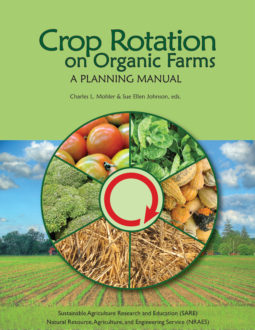The sample rotation sequences vary from farm to farm. The farmers explained that some cropping practices relate to the immediately preceding or following cash crop, and some relate to crops two or three seasons apart. Couplets of cover crops and cash crops are common. Careful examination of the crop sequences reveals several interesting points.
- For some fields, five years was inadequate to capture the full sequence of crops. For example, fields on Village Acres, Wood Prairie Farm, and Myers Farm are cycling through a longer period of cropping and have longer rotations due to the inclusion of perennial crops like hay and strawberries. In these cases, the crop sequences may show only two or three crops.
- Most of the farms rarely repeat a planting of the same crop family in the same field from one season to the next. When they do, they try to move the crops from bed to bed to avoid repeating on the same area of the field. This limits the buildup of soilborne pests and diseases.
- Most of the farms use a diversity of cover crops and plant a cover crop in most years. Some farms are exceptions, however. Notably, the two farms with the smallest acreage rely on compost to supply nitrogen and soil-building organic matter.
- A series of cover crops is grown in sequence on Nesenkeag Farm (rye-vetch intercrop, sudan grass, oat-pea intercrop). Riverbank Farm also follows rye with an oat-pea intercrop. In both cases, the sequence of cover crops is used to prepare the seedbed for high-value small-seeded crops.
- On those farms and on Golden Russet Farm, a winter-killed cover crop of oats and field peas tends to precede spring plantings of high-value direct-seeded crops with small seeds.
- Both cultivated fallows and mulching are important steps in sequences on some farms. Both are used for weed control.
- At Beech Grove Farm, crop rotation follows a fixed four-year cycle with pre-scheduled cultivated fallows and cover crops. The system is designed to minimize weeding and distribute labor. The vegetable production field is divided into 12 half-acre strips. In any particular year, only 6 of the strips are planted with vegetables.
- Each growing season, 3 strips are used for spring-planted vegetables and 3 strips for summer-planted vegetables. The remaining 6 strips are taken out of production. The strips that are out of production are cover cropped over the winter and produce substantial biomass. For six weeks during midsummer they are shallowly tilled several times, then planted to another cover crop in early August. Winter-killed covers like oats and field pea are used in strips that will be planted to early vegetable crops. Winter-hardy cover crops like rye and hairy vetch are used in strips where vegetable crops will be planted the following summer. This creates a four-year rotation cycle of (1) cover crops and fallow, (2) early vegetables followed by cover crops, (3) cover crops and fallow, and (4) summer vegetables. Alternating cash crops with bare fallow and cover crops appears to have exhausted the weed seed bank and built high soil quality. As a result, weed control needs and weed competition are minimal even when weather interferes with timely cultivation. Harvest and planting efforts are spread across the season.
- Brassicas are often followed by a grass cover crop (with or without a legume). Farmers indicated that this is because brassicas are nutrient-demanding crops, and a cover crop is needed to rebuild the soil and provide quick soil cover.
- Cucurbits tend to follow a cover crop or an early salad crop—spinach, lettuce, or brassica greens. Planting cucurbits is delayed until early summer, to allow double cropping of the same ground in a single season.
- Tomatoes, potatoes, and peppers (nightshades) are often preceded by a legume like clover, vetch, or hay. On two farms nightshades are preceded by fallow, in part to improve weed control and in part to increase available soil nitrogen through breakdown of a cover crop.
- Fair Hills Farm operations are based around its dairy and feed sales to organic dairies. As on many dairies in the northeast US, grasses are grown continuously (corn-rye-corn) for several years before rotation into alfalfa or mixed hay. Predominance of grasses in the rotation seems to cause few problems, possibly because the application of manure supplies nutrients and harvest and removal of the entire aboveground portion of the rye and corn plants for silage keeps pest populations in check.
